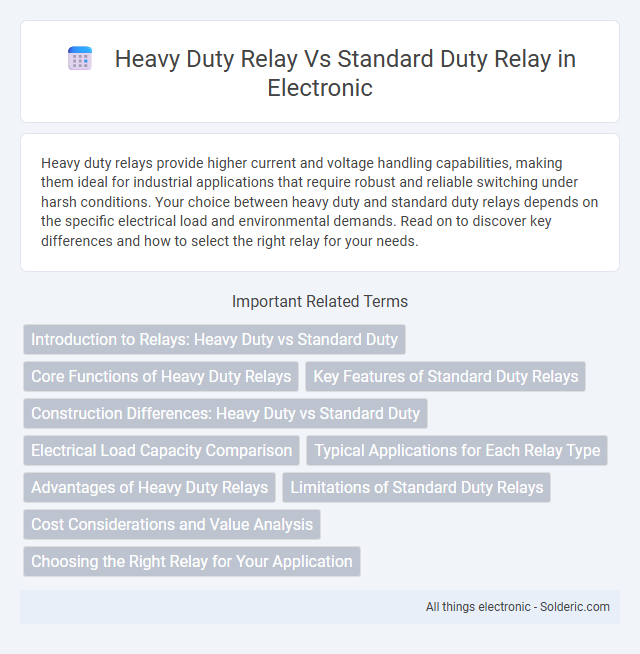Heavy duty relays provide higher current and voltage handling capabilities, making them ideal for industrial applications that require robust and reliable switching under harsh conditions. Your choice between heavy duty and standard duty relays depends on the specific electrical load and environmental demands. Read on to discover key differences and how to select the right relay for your needs.
Comparison Table
| Feature | Heavy Duty Relay | Standard Duty Relay |
|---|---|---|
| Current Rating | High (typically 30A to 100A+) | Low to Moderate (typically up to 30A) |
| Applications | Industrial machinery, automotive, HVAC, heavy equipment | Consumer electronics, lighting control, small appliances |
| Durability | Designed for rugged environments, longer operational life | Suitable for standard environments, shorter lifecycle |
| Contact Material | Silver alloy or other high endurance materials | Standard silver or copper alloys |
| Coil Voltage Range | Wide range, including 12V, 24V, 48V, 110V, 220V | Typically 5V, 12V, 24V |
| Switching Speed | Moderate, optimized for heavy loads | Fast, optimized for low power switching |
| Price | Higher cost due to enhanced specs | Lower cost, economical choice |
Introduction to Relays: Heavy Duty vs Standard Duty
Heavy duty relays are designed to handle higher current loads and more demanding industrial applications compared to standard duty relays, which are suitable for lighter, less intense electrical circuits. Your choice depends on factors such as the electrical load, frequency of operation, and environmental conditions where the relay will be used. Heavy duty relays often feature robust construction and enhanced durability, ensuring reliable performance under harsher conditions.
Core Functions of Heavy Duty Relays
Heavy duty relays are designed to handle higher electrical loads and provide greater durability compared to standard duty relays, making them ideal for industrial and automotive applications. Their core functions include managing large current switching, ensuring reliable operation under harsh conditions, and offering extended lifespan through robust construction. You benefit from enhanced performance and safety when using heavy duty relays in demanding environments.
Key Features of Standard Duty Relays
Standard duty relays typically feature coil voltages ranging from 5V to 48V and contact ratings up to 10A, making them suitable for low to moderate power applications. Their compact design, quick switching capabilities, and lower cost optimize them for control circuits and small signal switching. Standard duty relays often include sealed or open-frame configurations, providing flexibility for various environmental conditions.
Construction Differences: Heavy Duty vs Standard Duty
Heavy duty relays feature robust construction with thicker contacts, reinforced coil insulation, and durable housing materials designed to withstand high current loads and harsh environmental conditions. Standard duty relays have lighter, less durable components suitable for lower current applications and less demanding operational environments. Your choice between these relays depends on the reliability requirements and electrical load capacity needed for your specific application.
Electrical Load Capacity Comparison
Heavy duty relays typically offer significantly higher electrical load capacity compared to standard duty relays, often handling currents upwards of 30A to 40A or more, whereas standard duty relays are generally rated for lower currents around 10A to 20A. The robust design of heavy duty relays includes enhanced contacts and heat dissipation features to support heavy electrical loads in industrial or high-demand applications. Your choice between these relays depends on the specific load requirements of your electrical system to ensure durability and reliable performance.
Typical Applications for Each Relay Type
Heavy duty relays are typically used in industrial machinery, motor controls, and HVAC systems where frequent switching and high current loads are common. Standard duty relays suit applications such as automotive circuits, home appliances, and low-power electronic devices, where switching demands are moderate. Choosing the appropriate relay depends on the required durability, current rating, and operational environment of each application.
Advantages of Heavy Duty Relays
Heavy duty relays offer enhanced durability and high current-carrying capacity, making them ideal for industrial and heavy machinery applications. Their robust construction ensures reliable performance under extreme conditions, reducing downtime and maintenance costs. Choosing a heavy duty relay can significantly improve the longevity and efficiency of Your electrical systems.
Limitations of Standard Duty Relays
Standard duty relays have limitations including lower current and voltage ratings, which restrict their use in high-power or industrial applications. They typically have reduced mechanical durability and shorter operational life spans compared to heavy duty relays, making them less reliable for continuous or demanding switching tasks. Your equipment may experience failures or increased maintenance costs if a standard duty relay is used beyond its designed capacity.
Cost Considerations and Value Analysis
Heavy duty relays typically cost more upfront than standard duty relays due to their robust construction and higher current handling capacity. You gain long-term value from heavy duty relays through enhanced durability and reduced maintenance needs in demanding industrial environments. Standard duty relays offer lower initial expenses but may incur higher replacement and downtime costs when used beyond their design limits.
Choosing the Right Relay for Your Application
Heavy duty relays are designed to handle higher current loads and offer greater durability, making them ideal for industrial machinery and automotive systems where frequent switching and high power are required. Standard duty relays suit low to moderate load applications, such as residential appliances or control circuits, where reliability under lighter electrical stress is sufficient. Selecting the right relay involves evaluating load requirements, switching frequency, and environmental conditions to ensure optimal performance and longevity.
Heavy duty relay vs standard duty relay Infographic

 solderic.com
solderic.com